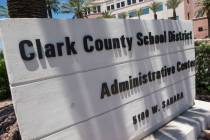Governor plans 5 percent cut in allocation for public schools and higher education


CARSON CITY — While Gov. Brian Sandoval doesn’t recommend cutting school teacher and college professor salaries, key members of his administration said Thursday he intends to reduce what the state spends on public schools and higher education by 5 percent.
That leaves it up to school district trustees and the Board of Regents to decide whether to cut employee salaries or find other sources of revenue to prevent wage reductions.
The 5 percent reductions, including those that have been proposed for state workers, and the elimination of longevity and merit pay will save the state $591 million over the next two years, said Heidi Gansert, Sandoval’s chief of staff.
In a news conference, Gansert said school districts need to take into account the possible funding reduction as they negotiate contracts with school employee unions.
"They are probably in (collective bargaining) negotiations now," said Gansert, former Assembly minority leader. "It is going to be up to the schools and their negotiators."
Lynn Warne, president of the Nevada State Education Association, said Thursday she figured the Sandoval administration would come up with something that at least indirectly would affect teacher pay. She said she has been hearing Sandoval expects to make a $500 million reduction in school spending.
Sandoval aides told the Review-Journal on Wednesday night that the governor was not proposing teachers take a 5 percent pay cut, but it now is clear that the governor is leaving that choice to local school boards.
In a letter to state employees Wednesday, the governor said he wants them to take a 5 percent wage cut and end the one-day-per-month furloughs they have been taking since July 2009.
Warne noted that the newspaper Education Week, in a current survey, ranked Nevada fourth from the bottom in public school funding and at the bottom in students’ chance for success.
"We need an honest conversation on how to develop quality education in this state that involves revenue," Warne said. "Unfortunately the failed mantra of ‘no new taxes’ is what this governor is proposing."
The National Education Association in 2008 put average Nevada teacher pay at $44,426 a year. Based on that figure, the average teacher would receive $2,221 less a year.
Clark County School Board President Carolyn Edwards was unclear how the governor’s proposal would affect schools, saying a 5 percent cut in total funding might entail more than just reducing school employees’ salaries by 5 percent.
"We need to see the whole picture," Edwards said.
"Cutting education is not the way to go," said Ruben Murillo, president of the Clark County Education Association, which represents local teachers.
Murillo said Sandoval at least should consider "revenue enhancements," such as increases to taxes and fees.
The cuts Sandoval proposes will not go into effect unless approved by both Democrat-controlled houses of the Legislature.
Gov. Jim Gibbons proposed a 6 percent pay cut for state workers two years ago. Instead, legislators passed a law requiring most employees to take a monthly furlough day, cutting payroll costs by 4.6 percent.
Assembly Speaker-elect John Oceguera, D-Las Vegas, didn’t take a position Thursday on the salary reductions.
"Once we have the governor’s budget in its entirety, we will be able to better assess the 5 percent payroll cut proposed by the governor, but this will be painful for state workers and their families, and we need to keep in mind that they have already taken deep cuts," Oceguera said in a statement.
Sen. Mike Schneider, D-Las Vegas, said Wednesday evening he would not support cuts in teacher pay.
Schneider called Nevada "the cheapest state." He said one of the primary reasons why businesses do not locate here is the lack of a quality education system.
Dale Erquiaga, Sandoval’s chief adviser, said Thursday there has been a "mixed bag" reaction from state workers since the governor announced he wants to end furloughs and cut state employee pay.
Erquiaga said some employees think that the Sandoval plan is unfair and that they should be given time off if they are going to work for less pay. But others accept it as a natural response by the governor to deal with declining state revenue.
Gansert said it is almost impossible to keep up with work at agencies such as the Department of Motor Vehicles with employees off on furloughs.
Ending furloughs will bring better service to the public, she said.
Gansert would not disclose additional details about what the governor will propose in his State of the State message and the two-year budget he will release to the Legislature on Jan. 24.
But she said the payroll reduction figure of $591 million is built into the budget.
Some of the cuts proposed by Gibbons before he left office Jan. 3 also are in the Sandoval budget. Gibbons requested state agencies come up with ways to reduce their spending by 10 percent.
Those cuts added up to $819 million. They included reducing basic support for public schools and full-day kindergarten programs, ending a senior citizen property tax rebate program, reducing funding for mental health services and no longer providing dentures for people receiving Medicaid, the free health care program for the poor, blind and disabled.
Sandoval has said that he will veto any tax increase and that his budget will be based entirely on the $5.33 billion in revenue forecast for the state over the next two-year budget period. Current state spending is $6.4 billion.
Gansert refused to say whether Sandoval’s budget has been balanced with the cuts initially proposed by Gibbons and the pay reductions sought by the new governor.
Erquiaga said Sandoval probably will not close four state museums and historical societies as has been reported by other media. The Lost City Museum in Overton is one of the four facilities that had been mentioned as closing.
Erquiaga, who headed state museums for a time under Gov. Kenny Guinn, said museums and historical societies have been hit harder during the recession than other state agencies and should not be forced to cut more.
Erquiaga announced that Sandoval plans to seek a constitutional amendment to allow the state to give vouchers to parents who send their children to parochial schools. Through vouchers, parents would receive state money to pay the private, charter or parochial schools that their children attend.
Erquiaga said this change is part of the governor’s "parental choice" plan to let parents decide how best to provide a quality education for their children.
Sandoval is a product of Catholic schools in Reno, and his oldest child is attending a Catholic high school.
In his State of the State message, the governor will talk about collective bargaining. But unlike Gibbons, Sandoval does not want to eliminate collective bargaining, Erquiaga said.
Gibbons drew up nine bills for consideration by the Legislature, and Erquiaga said people should "not assume" Sandoval supports any of them.
Reporter Jim Haug contributed to this report. Contact Capital Bureau Chief Ed Vogel at evogel@reviewjournal.com or 775-687-3901.


















